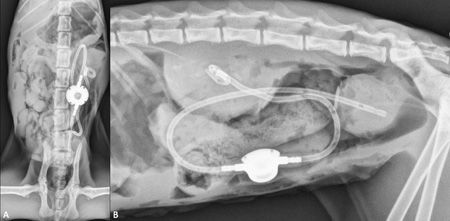Cutting-edge approach solves the riddle of a sphynx's blocked ureter
The veterinary team at UC Davis implanted an artificial ureter-the first such procedure in a kitten.

Googgie is good to go. The sphynx kitten is thriving after undergoing a subcutaneous ureteral bypass. (Photos courtesy of UC Davis.)
Googgie, a 17-week-old spayed female sphynx, is back in business after receiving an artificial ureter from the University of California, Davis. Originally brought to UC Davis' Emergency and Critical Care Service because of inappetence, lethargy and vomiting of three days' duration, Googgie was found to have an enlarged and painful left kidney, according to a press release from UC Davis.
An ultrasonographic examination revealed an obstructed left ureter preventing flow of urine to the bladder, so Googgie underwent surgery to discover the cause. A traumatic stricture was found around the ureter, preventing it from being open.
To treat the obstruction, William Culp, DVM, DACVS, tried a new procedure that had previously been used in adult dogs and cats only. The procedure, known as a subcutaneous ureteral bypass (SUB), involves bypassing the natural ureter and using tubing to create two ends of a new ureter from the kidney to the bladder. The surgeons also placed a titanium shunting port subcutaneously so that urine samples could be collected easily.

An inside view. A radiograph showing the placement of Googgie's artificial ureter.
The surgeons were able to perform the procedure minimally invasively, using interventional radiology to guide placement of the implant. Googgie recovered well and, several hours after the procedure, was bright and eating and drinking. She received intravenous fluid therapy, pain medication and lots of TLC from the UC Davis veterinary team and was then discharged after about a week. The swollen kidney had resolved and the SUB system remained in place on a follow-up ultrasonographic examination. In addition, tests confirmed normal kidney function.
Googgie continued to have positive reports on three-week and three-month rechecks-she is growing like a normal cat. She will need to be monitored long-term because the longevity of the system for longer installation into young animals is unknown. Initial data regarding use of SUB systems indicate fewer long-term complications compared with traditional ureteral surgery, according to the press release. Since conventional methods to correct ureteral obstructions are often less than optimal, it is hopeful that implantation of this SUB system will hold promise as a viable alternative.